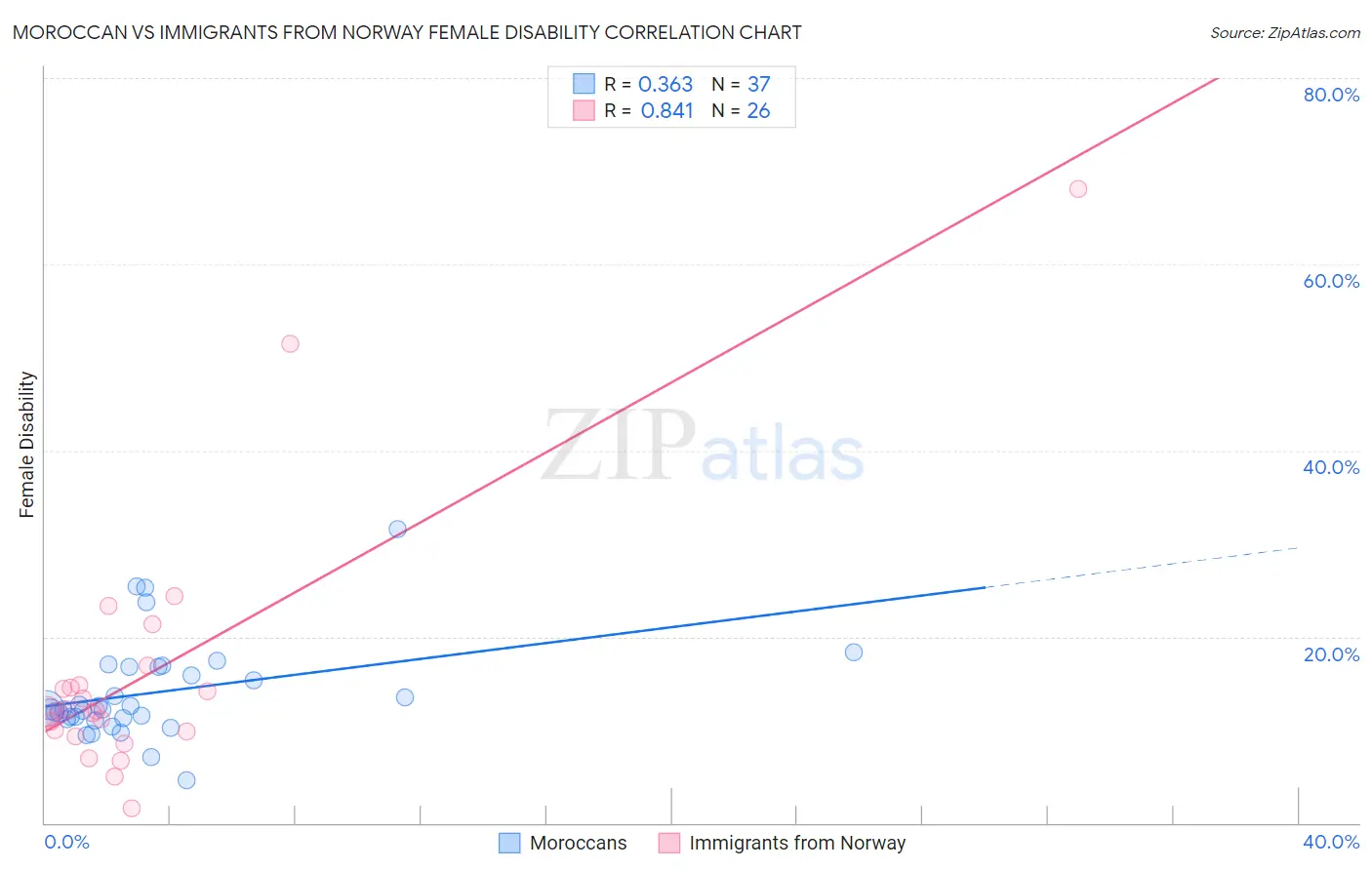Moroccan vs Immigrants from Norway Female Disability
COMPARE
Moroccan
Immigrants from Norway
Female Disability
Female Disability Comparison
Moroccans
Immigrants from Norway
12.1%
FEMALE DISABILITY
72.9/ 100
METRIC RATING
156th/ 347
METRIC RANK
11.9%
FEMALE DISABILITY
93.8/ 100
METRIC RATING
137th/ 347
METRIC RANK
Moroccan vs Immigrants from Norway Female Disability Correlation Chart
The statistical analysis conducted on geographies consisting of 201,802,269 people shows a mild positive correlation between the proportion of Moroccans and percentage of females with a disability in the United States with a correlation coefficient (R) of 0.363 and weighted average of 12.1%. Similarly, the statistical analysis conducted on geographies consisting of 116,702,841 people shows a very strong positive correlation between the proportion of Immigrants from Norway and percentage of females with a disability in the United States with a correlation coefficient (R) of 0.841 and weighted average of 11.9%, a difference of 1.7%.

Female Disability Correlation Summary
| Measurement | Moroccan | Immigrants from Norway |
| Minimum | 4.6% | 1.5% |
| Maximum | 31.6% | 68.1% |
| Range | 27.0% | 66.6% |
| Mean | 14.0% | 16.0% |
| Median | 12.2% | 12.0% |
| Interquartile 25% (IQ1) | 11.2% | 9.8% |
| Interquartile 75% (IQ3) | 16.8% | 14.8% |
| Interquartile Range (IQR) | 5.6% | 5.0% |
| Standard Deviation (Sample) | 5.3% | 14.1% |
| Standard Deviation (Population) | 5.3% | 13.8% |
Demographics Similar to Moroccans and Immigrants from Norway by Female Disability
In terms of female disability, the demographic groups most similar to Moroccans are Ghanaian (12.1%, a difference of 0.19%), Syrian (12.1%, a difference of 0.20%), Sudanese (12.0%, a difference of 0.33%), Immigrants from Scotland (12.0%, a difference of 0.34%), and Icelander (12.0%, a difference of 0.42%). Similarly, the demographic groups most similar to Immigrants from Norway are Ugandan (11.9%, a difference of 0.040%), Ecuadorian (11.9%, a difference of 0.060%), Immigrants from Hungary (11.9%, a difference of 0.15%), Romanian (11.9%, a difference of 0.31%), and Immigrants from Ecuador (11.9%, a difference of 0.33%).
| Demographics | Rating | Rank | Female Disability |
| Ugandans | 94.0 /100 | #136 | Exceptional 11.9% |
| Immigrants | Norway | 93.8 /100 | #137 | Exceptional 11.9% |
| Ecuadorians | 93.4 /100 | #138 | Exceptional 11.9% |
| Immigrants | Hungary | 92.8 /100 | #139 | Exceptional 11.9% |
| Romanians | 91.6 /100 | #140 | Exceptional 11.9% |
| Immigrants | Ecuador | 91.5 /100 | #141 | Exceptional 11.9% |
| Immigrants | Africa | 90.0 /100 | #142 | Excellent 11.9% |
| Immigrants | Sudan | 89.6 /100 | #143 | Excellent 11.9% |
| Immigrants | Austria | 87.9 /100 | #144 | Excellent 12.0% |
| Estonians | 87.8 /100 | #145 | Excellent 12.0% |
| Pakistanis | 84.6 /100 | #146 | Excellent 12.0% |
| Nigerians | 84.0 /100 | #147 | Excellent 12.0% |
| Immigrants | Kenya | 83.1 /100 | #148 | Excellent 12.0% |
| Greeks | 82.0 /100 | #149 | Excellent 12.0% |
| Immigrants | Moldova | 81.4 /100 | #150 | Excellent 12.0% |
| Icelanders | 80.7 /100 | #151 | Excellent 12.0% |
| Immigrants | Scotland | 79.3 /100 | #152 | Good 12.0% |
| Sudanese | 79.1 /100 | #153 | Good 12.0% |
| Syrians | 76.9 /100 | #154 | Good 12.1% |
| Ghanaians | 76.6 /100 | #155 | Good 12.1% |
| Moroccans | 72.9 /100 | #156 | Good 12.1% |